There is so much to do in Spain’s capital, we recommend at least three days in Madrid. However, Madrid also makes an excellent base for some of Spain’s best day trips.
Using Spain’s excellent high-speed train system, it is possible to visit some of the best attractions on day trips from Madrid. So while at least three days in Madrid is optimal, a few days extra will allow you to access some of the country’s most incredible cities and attractions.
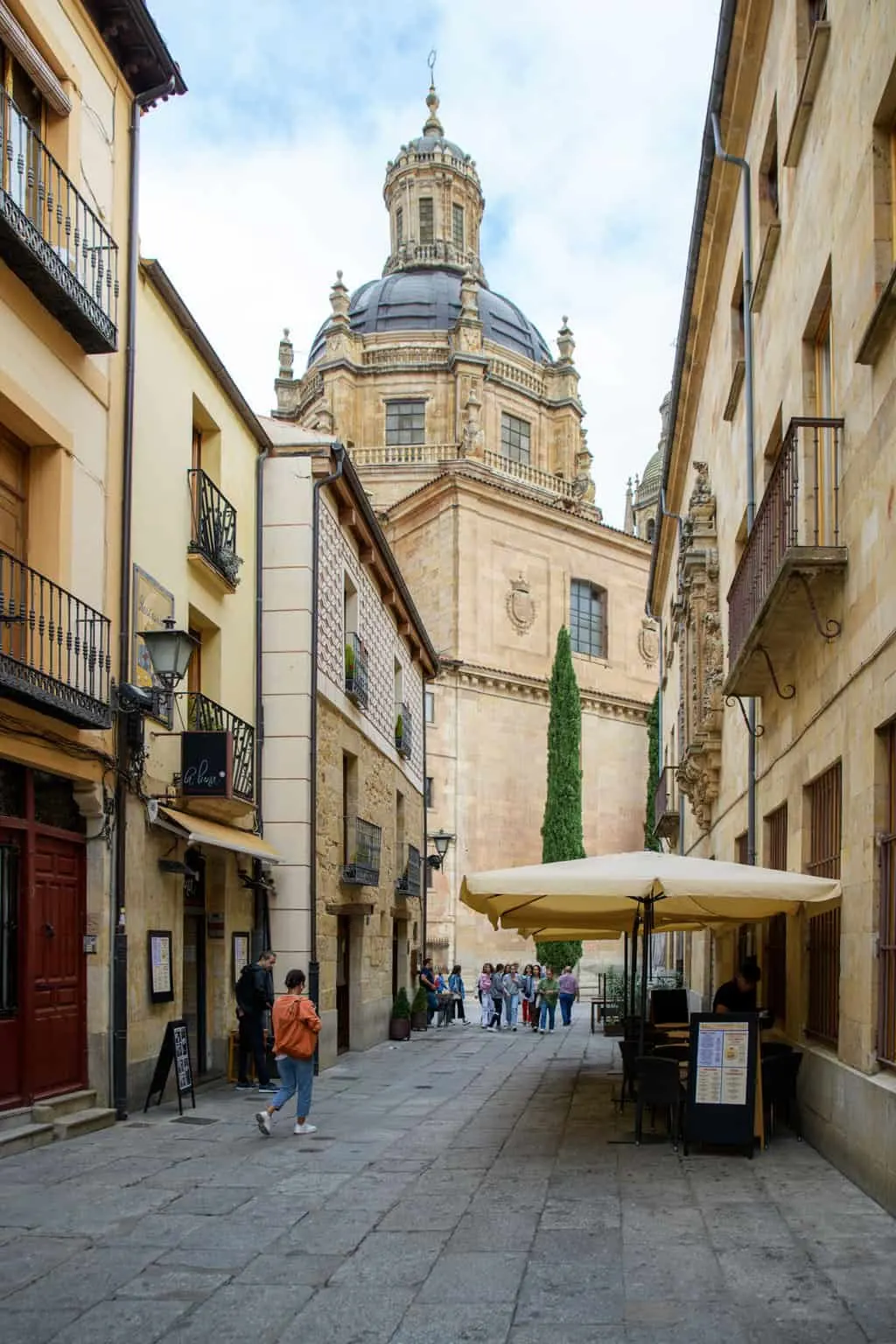
How to Get Around
Each day trip listed has information on how to get there, or we recommend tours that might make better sense or offer exceptional value.
The train is usually the best way to travel around Spain – this is the case with many of these day trips. However, some of the best day trips from Madrid are better if done by car. Driving allows you to visit multiple towns or cities in one day where they are close. It also allows you the flexibility of exploring the magnificent countryside, wine regions and smaller towns where transport may be tricky.
Car hire from Madrid is very reasonable – Discover Cars search for the best rates in Madrid with prices as little as €75 for two days in a small car – perfect for navigating Madrid city and the small towns and cities. See here to compare car rental rates.
Search the Best Accommodation Deals in Madrid
The Best Day Trips from Madrid
San Lorenzo de El Escorial Monastery and Palace
1 hr from Madrid | 58 km | Unesco Listed Palace
Less than an hour from Madrid, nestled in the southern slopes of the Sierra de Guadarrama, is the quaint 16th-century town of San Lorenzo del Escorial (El Escorial). It is home to the UNESCO-listed Royal Monastery and Palace of El Escorial.
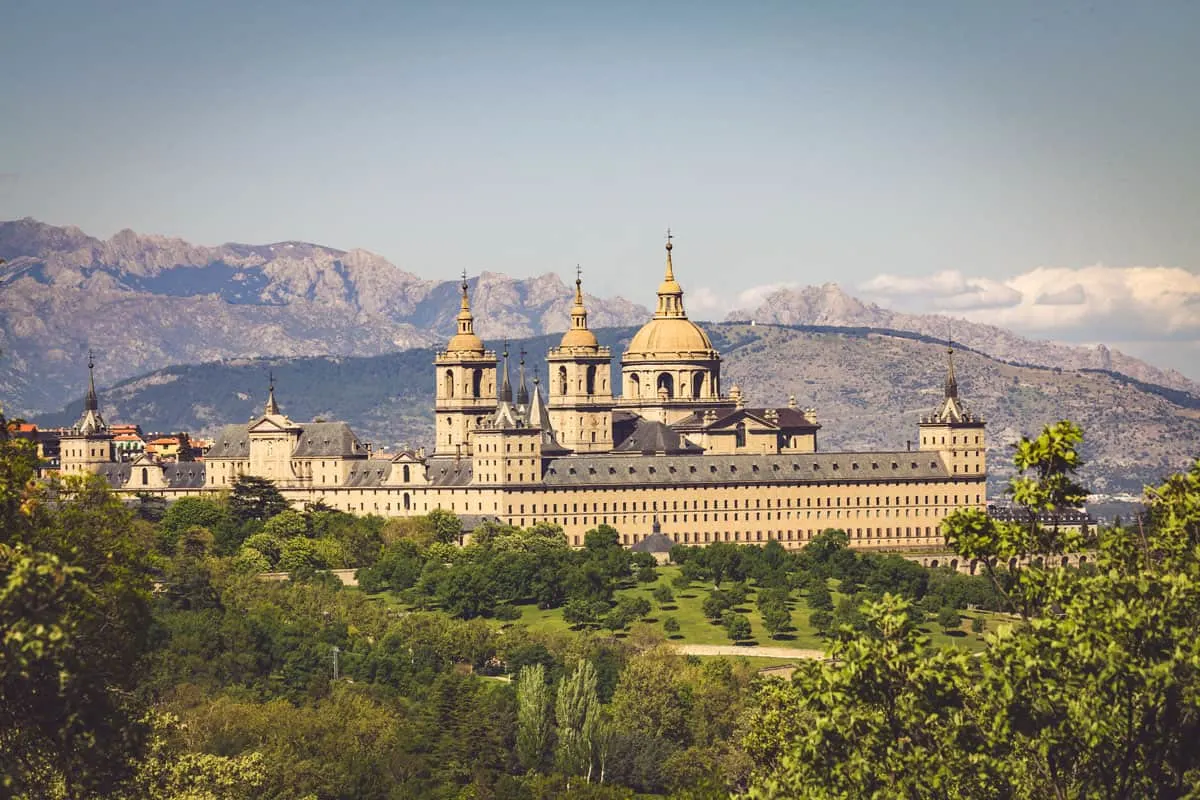
Just one of Spain’s many UNESCO sites, the Royal Monastery and Palace of El Escorial hold great significance. One of the most popular day trips from Madrid, The Monastery of San Lorenzo de El Escorial is easy to access. The town also offers visitors a lot to see in the way of charming shops and traditional restaurants.
Initially conceived as a monastery in the 16th century and a mausoleum for the royal family, the royal residence grew to include a basilica, a library containing over 40,000 books, two royal palaces and magnificent halls and gardens.
The Pantheon of the Kings is a highlight – the remains of every monarch since the 16th century are laid to rest in breathtaking gold and marble tombs.
The nearby Valley of the Fallen is worth a stop to see the controversial Civil War Monument. An enormous 150-meter cross towers over a basilica which Dictator Francisco Franco claimed was a “national act of atonement” and reconciliation.
If You Have Time: Combine this with a trip to Toledo, Segovia or Salamanca, which are within easy reach.
Tour Recommendation: If you prefer to visit San Lorenzo de El Escorial with a guided tour, you can take an El Escorial and Valley’s Basilica Half-Day Tour from Madrid. The five-hour tour includes return transport, guides, and entry to the Monastery, royal monuments, the Valley of the Fallen and the Basilica with audio guides. See here for full tour details.
For a full-day tour that combines two historical sites, try the Toledo and El Escorial tour from Madrid, recommended below.
How to get to San Lorenzo de El Escorial from Madrid
- Bus: Approximately 1 hr. Take bus lines 661 and 664 from the Moncloa transport hub. The 664 bus is the most direct and drops you very close to the monastery.
- Train: Approximately 1 hr. Take the regional train C8a from Atocha station. It is around a 10-minute walk to the monastery.
- Car: Approx. Fifty-five minutes from central Madrid.
Toledo
1 hour from Madrid | 74 km | UNESCO Site and Moorish Architecture
One of the most popular day trips from Madrid and one of Spain’s most visited UNESCO sites, there are plenty of reasons to visit Toledo.
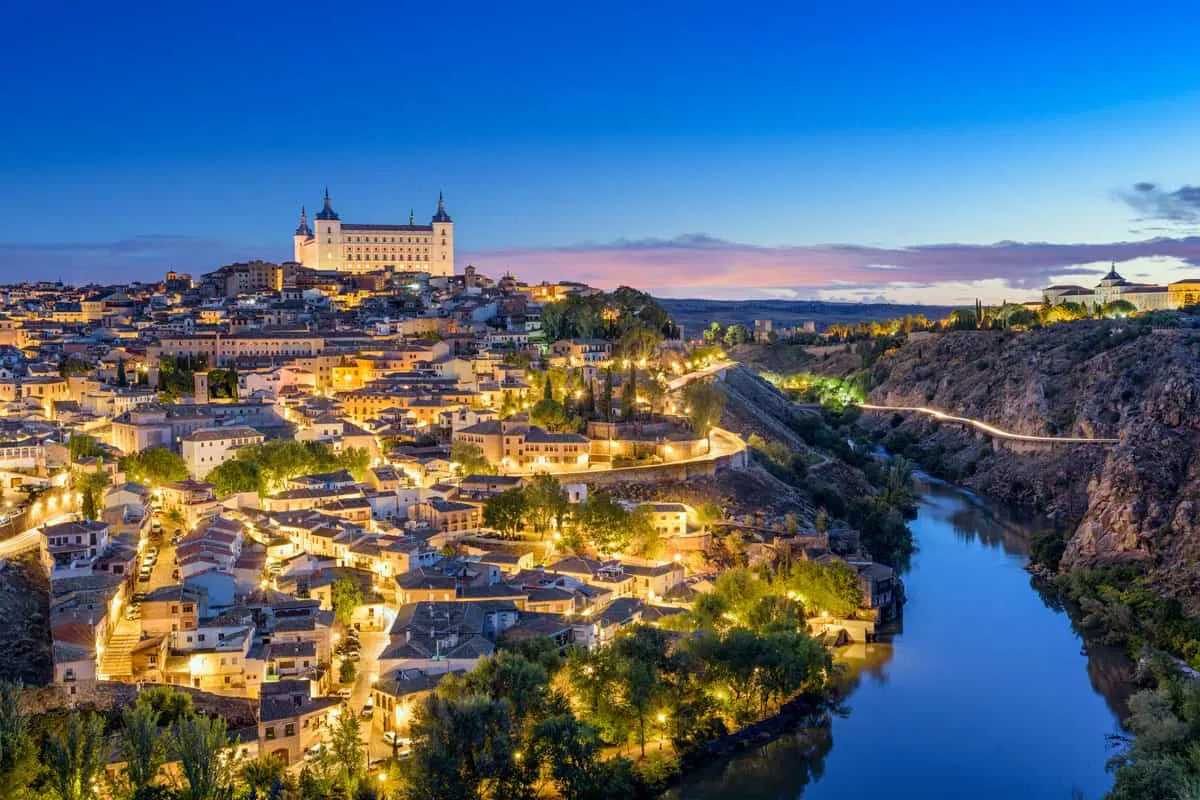
Called the “City of Three Cultures”, Toledo is a rare city where Islamic, Hebrew and Christian faiths lived and co-existed harmoniously. The influence of its successive Christian, Muslim, and Jewish occupants reflected in the architectural, cultural and artistic legacies.
Visitors can trace this fascinating history within the medieval walls, exploring the narrow cobbled streets to discover a magnificent array of churches, convents, monasteries, synagogues, and mosques.
Situated on a hill with sweeping views of the Río Tajo, the Alcázar is a must-see. See the magnificent Gothic Cathedral of Toledo and the oldest standing synagogue in Europe, Santa Maria la Blanca. Visit the EL Greco Museum to learn about the great Spanish Renaissance artist El Greco who was granted artistic sanctuary in Toledo.
Toledo also has a long history of creating prized forged steel throughout history and continues to produce swords and armour, including for Hollywood productions. Take a tour of the steel forge for a very different view of Toledo’s history.
Don’t Miss: Enjoy the traditional Marzipan sweets invented by the nuns of Toledo around 1150. You can find them in local stores or buy them directly from the convents where nuns still make them. Try the Monasterio de San Clemente or Monasterio de Mochas Comemdadoras de Santiago.
Tour Tip: The full-day Toledo and El Escorial tour from Madrid includes two historic sites in one day, visiting all the major attractions, and a demonstration of the famous damascened technique – the inlaying of precious metals in steel and the forging of swords.
How to get to Toledo from Madrid
- Bus: Approximately 1 hr. from Plaza Eliptica bus station. You will need to get the metro to the bus station from Madrid.
- Train: 30 minutes to 1 hr, depending on the service. Trains depart from Atocha Station in Madrid. The Toledo train station is outside the historic centre. You can take a bus (number 5, 61, or 62), a taxi, or a leisurely 25-minute walk to the historic centre.
- Car: Approx. 1 hr from central Madrid.
La Mancha
1.40 hrs driving or bus 2.5 hrs | 132 km to Consuegra | Historical Route, wine region, natural heritage
La Mancha is the stunning wine region in central Spain that provided the setting for the adventures of the famous 17th century literary hero Don Quixote of La Mancha by Cervantes.
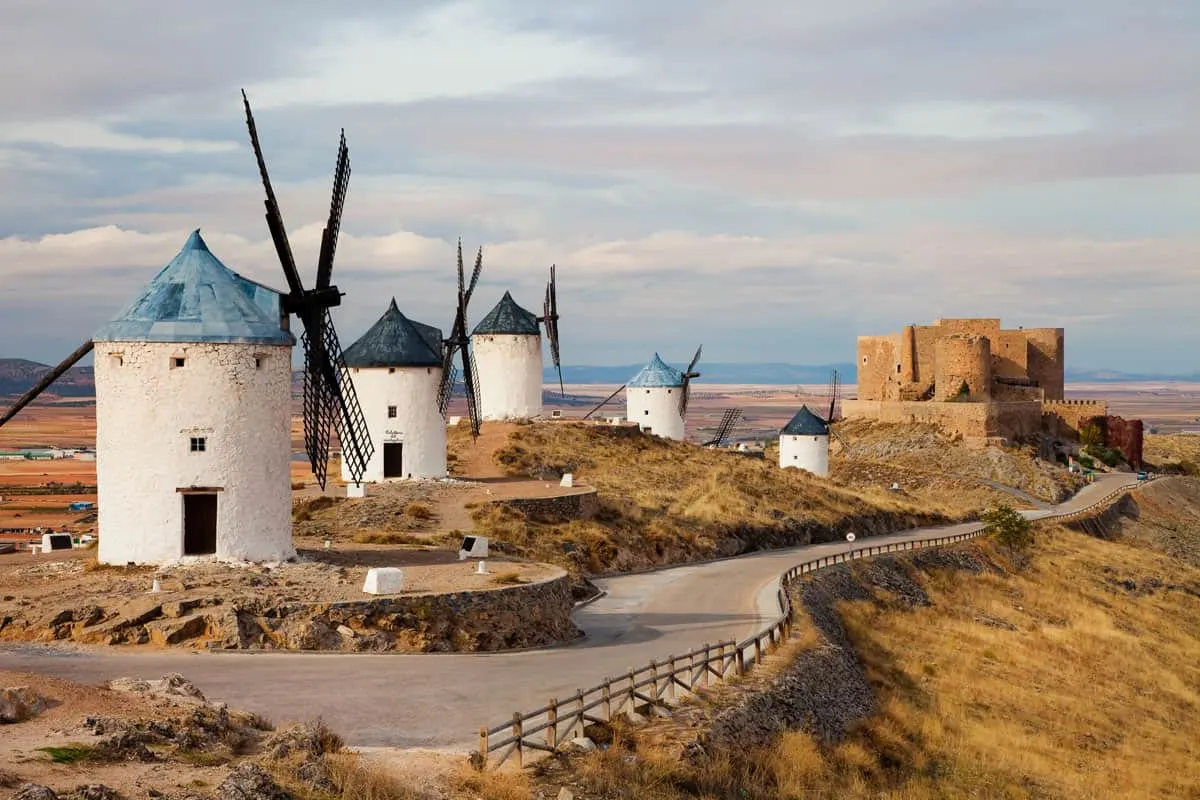
Spain’s most prominent wine region and one of the largest wine-producing regions in the world, La Mancha, is where hundreds of wineries thrive, using traditional winemaking methods, despite challenging growing conditions.
Follow the steps of Don Quixote along the Castilla-La Mancha windmills route. The route takes you through several towns, including Consuegra in the heart of Castilla–La Mancha, where you will find 12 of the original windmills dating back to the 16th century. Most have been restored and are open to the public. The parking area close to the last windmill offers the best views over the hill.
Campo de Criptana sets the scene for chapter eight of Don Quixote – “At this point, they caught sight of thirty or forty windmills which were standing on the plain…”. There is a charming restaurant with a view of the windmills where you can try local specialities like the famous Manchega cheese.
If You Can: Visit La Mancha in October when the fields around Consuegra turn purple thanks to the dainty crocus flowers that provide the precious saffron. Consuegra’s Saffron Festival celebrates the cultivation of saffron in late October.
Tip: It is possible to make a combined Toledo and Consuegra day trip from Madrid. Or, if you have time, stay in Toledo and continue to Consuegra the next day.
How to get to Consuegra from Madrid
- Bus: Approximately 2.5 hrs from Madrid or 1.5 hrs from Toledo.
- Train: There are no train services to Consuegra.
- Car: Approx. 1.40 hrs from central Madrid.
Royal Palace of Aranjuez
45 minutes | 48 km | UNESCO Site, Royal Palace and Nature
Aranjuez is one of the most accessible day trips from Madrid, which you can combine with a visit to Toledo if you are short on time.
A UNESCO World Heritage Cultural Landscape, the city of Aranjuez, boasts some of the most spectacular heritage in Spain.
The highlight of the charming city on the banks of the Tagus River is the 16th-century Royal Palace of Aranjuez and its spectacular royal gardens. The royal residence served as a country escape for kings and queens. The complex displays the wide variety of styles of the monarchs that continued the enhancement of the property over the centuries.
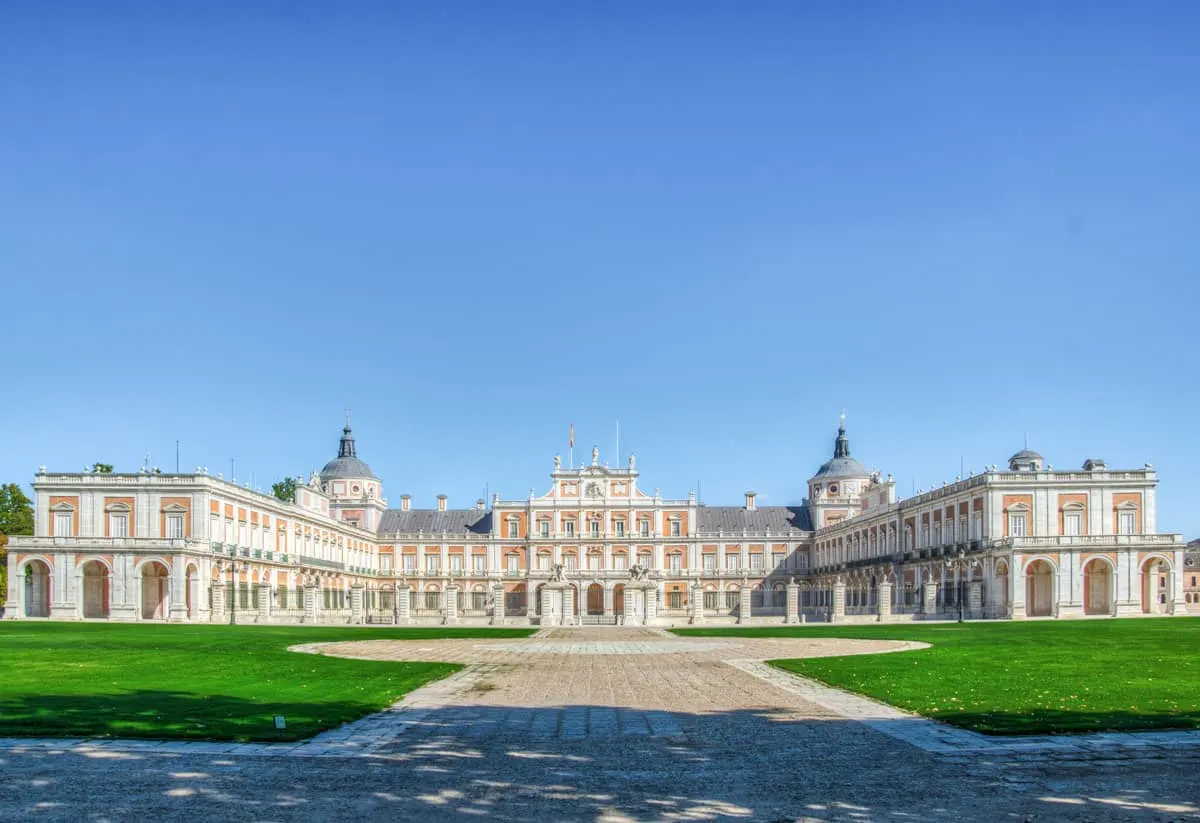
Some of the palace’s highlights are the Chapel Royal by Sabatini and the opulent Throne Room. Don’t miss the dazzling display of ornate Buen Retiro porcelain plaques depicting Chinese scenes in the Porcelain Room. The Chinese Room has over 200 delicate paintings on rice paper, a gift to Queen Isabella II from the Emperor of China.
The magnificently intricate Arab Cabinet was modelled on the Sala de Dos Hermanas of the Alhambra in Granada, built in the mid-1800s as a private smoking room for the consort Don Francisco de Asis.
Initially established as a royal hunting lodge, the palace boasts over 100 acres of magnificently ornate gardens and woodlands filled with ancient trees and exotic plants tracing the Tagus.
How to Get to Aranjuez
- Bus: Approximately 50 minutes. Buses leave from Estación Sur de Autobuses de Madrid.
- Train: Approximately 45 minutes. Take The regular commuter C3 train from Madrid Atocha Cercanias. It is around a 10-minute walk to the palace.
- The Strawberry Train: Approx 50 minutes in spring and summer only. The Strawberry Express (Tren de la Fresa) is a highlight. The early 20th-century steam train with wooden carriages runs from the Madrid Railway Museum to Aranjuez on several weekends from April to October. Hostesses in period costume hand out locally grown strawberries throughout the journey.
- Car: Approx. Fifty minutes from central Madrid.
Segovia
1 hr driving or 30 minutes train | 91 Km | UNESCO City, Roman Aquaduct, Gothic Castle and Cathedral
While Segovia lays claim to the best-preserved Roman aqueduct in Spain, it is just the tip of the iceberg of things to do in Segovia.
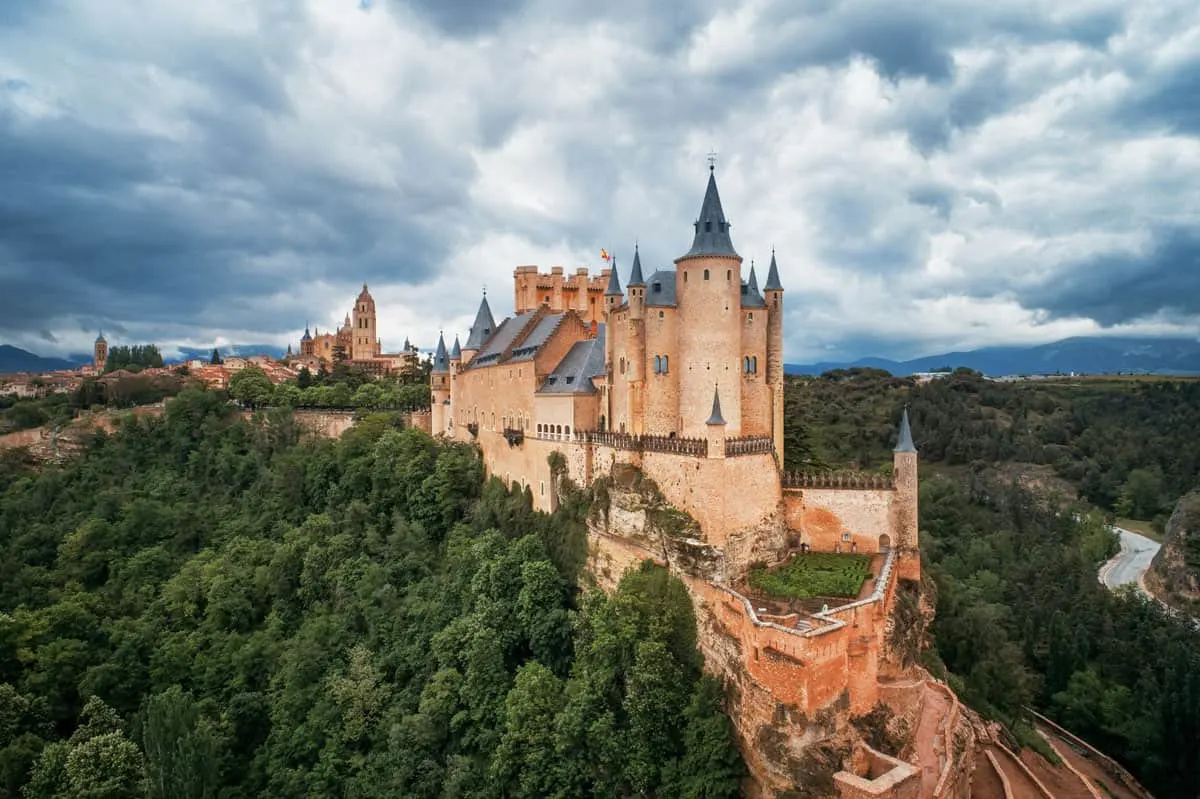
Dating back to the 1st century AD, the Segovia Aquaduct is one of Spain’s most significant and well-preserved Roman structures. All of its 167 original arches remain intact. The structure carried water from a river 17 kilometres (11 mi) away to the city’s fountains, public baths and houses until 1973.
UNESCO gave the historic centre of Segovia World Heritage status in 1985. Visit the Royal Museum of the Mint of Segovia and the magnificent Segovia Cathedral, one of the last built in Europe in the Gothic style.
Explore the charming tangle of medieval streets and the Jewish Quarter, which has many significant sites, including the Museo de Segovia and the Old Major Synagogue, now the Convent of the Corpus Christi Order of St. Clare, a cloistered order.
A highlight of Segovia is the 13th-century fairytale-style Alcazar. Built by Alfonso VIII on top of a rock with commanding views of the Castilian countryside, the Alcázar of Segovia is a work of Gothic elegance. Possibly Spain’s most famous castle, it is believed the Segovia Alcazar was part of the inspiration for Disney’s iconic Cinderella Castle.
Don’t Miss: Cochinillo Asado – roast suckling pig, a traditional dish of Segovia. The meat is so tender the side of a plate is used to slice it up.
If you have time, the elegant Palacio Real la Granja is only 10 km from Segovia in the little town of San Ildefonso in the Sierra de Guadarrama.
How to get to Segovia from Madrid
- Bus: Approximately 1 hr. Buses leave for Segovia from Moncloa Station in the north of Madrid and arrive in the historical centre in Segovia, which is very convenient.
- Train: Approximately 30 minutes on the high-speed AVE train from Chamartin station to Guiomar Station in Segovia. The high-speed station is 6km from the historic centre. You can take the bus to the centre or a taxi from the station.
- Car: Approx. 1 hr from central Madrid.
Tour Tip for Segovia: Take a Combined Avila and Segovia Day Trip from Madrid with Tickets to Monuments. Visit the picturesque cities of Segovia and Avila with entry and guided tours of the most iconic monuments in these UNESCO World Heritage cities.
Ávila
1.2 hours driving. 1.5 hrs train or bus | 109 km | UNESCO World Heritage site famous for its city walls and gastronomy
The gorgeous medieval World Heritage City of Ávila is as beautiful from afar as when exploring the narrow historic streets.
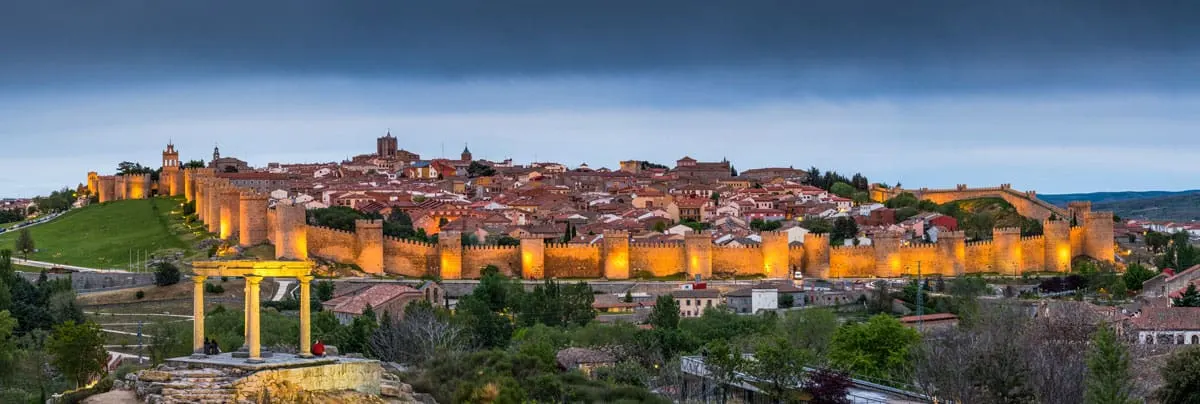
Also known as the Town of Stones and Saints, Avila’s walls and turrets are some of the best-preserved walls in Spain and some of the most complete in Europe. Once a military outpost, the strategic position led to the building of the Muralla de Ávila between the 11th and 14th centuries.
Tour tip: Maximise your time with a 2 hr Ávila old town private walking tour, including entrance to the walls.
Spanning 2.5km, nine entrances and defensive gates are within the walls and more than 80 watchtowers. It is a magnificent site visible from a great distance.
Inside the walls, explore the cobbled streets to discover its many significant sites, such as the cathedral. Considered to be Spain’s first Gothic cathedral, it also was fortified and is connected to the city walls.
A dedicated 1700-metre walkway along the top of the walls is open to the public. Take a lofty walk to enjoy magnificent views inside the walls over the cathedral and the Plaza del Mercado Grande and outside over the surrounding countryside.
Head to Cuatro Postes Viewpoint of Avila for the best views over the walled city. Especially at sunset when the wall lights up as the sun disappears.
Throughout the year, the city holds special events such as Medieval Days, also called “The Market of Three Cultures” (Christian, Jewish and Arabic), on the first weekend in September. There will be traditional Easter rituals and parades in March or April, and during summer, you can enjoy theatrical shows on the walls in the evenings.
Don’t Miss: Also known for its gastronomical heritage, Ávila is famous for its meat dishes, especially T-bone steaks. Enjoy a steak with beans from El Barco de Ávila, and Patatas Revolconas made with paprika and bacon. Yemas de Santa Teresa, a small round sweet made with egg yolks, lemon and cinnamon, is also very popular. Many restaurants in town will have a set menu, Degust Ávila lunch, where you can sample these local specialities.
How to get to Avila from Madrid
- Bus: Approximately 1.5 hrs. Buses leave for Avila from Estación Sur (also called Mendez Alvaro Station, connected by Metro line 6). It is a 15-20 minute walk to the historical centre from the bus station in Avila.
- Train: Approximately 1.5 hrs from Príncipe Pío Station. Avila station is very close to the city walls – approx. 15-minute walk. There is also a city bus. Make sure you buy a return ticket, especially in the peak season (best bought in advance), as they can sell out, and you may get stuck.
- Car: Approx. 1.2 hrs from central Madrid.
Pedraza
1.30 hr from Madrid or 35 minutes from Segovia | 128 Km from Madrid – 40 km from Segovia | Best preserved medieval village
Pedraza is a great side trip to Segovia if you are driving. The medieval town is only 40 km northeast of Segovia.
Declared a Monumental Complex in 1951, Pedraza is one of the best-preserved medieval towns in Spain. Surrounded by pristine landscapes, Pedraza offers exquisite culinary heritage, artisan bakers and shops offering products typical of the area. Pedraza is a taste of authentic Spanish culture and history.
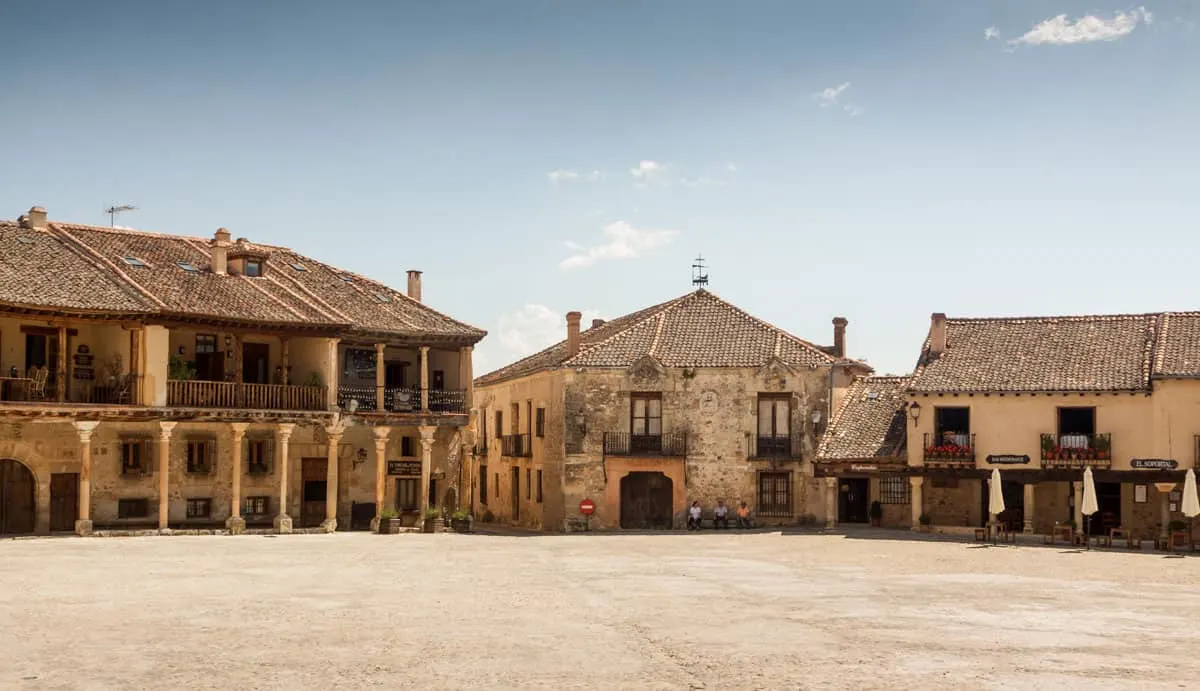
Visit the Pedraza Castle and Zuloaga Museum, the Imperial Eagle House and the village jail.
Pedraza also hosts many festivals and events, such as the Candle Concerts on the first and second Saturday of July. Thousands of candles illuminate the entire town of Pedraza, and concerts are held in various parts of the town.
Pedraza is home to the annual Fiestas Patronales from September 7-12, which sees bulls run through the winding streets in honour of its patron saint, the Virgen del Carrascal.
How to get to Pedraza
- Car: Car is the best way to get to Pedraza, either 1.30hr from Madrid or 35 minutes from Segovia
Alcalá de Henares
45 minutes driving or 25 minutes by train | 41 km from Madrid | UNESCO World Heritage Site | Birthplace of Cervantes
Literary lovers can indulge in the Spanish Golden Age in the birthplace of the famed author of Don Quixote – Miguel de Cervantes. Alcalá is where some of Spain’s most renowned artists and writers studied between the 15th and 17th centuries.
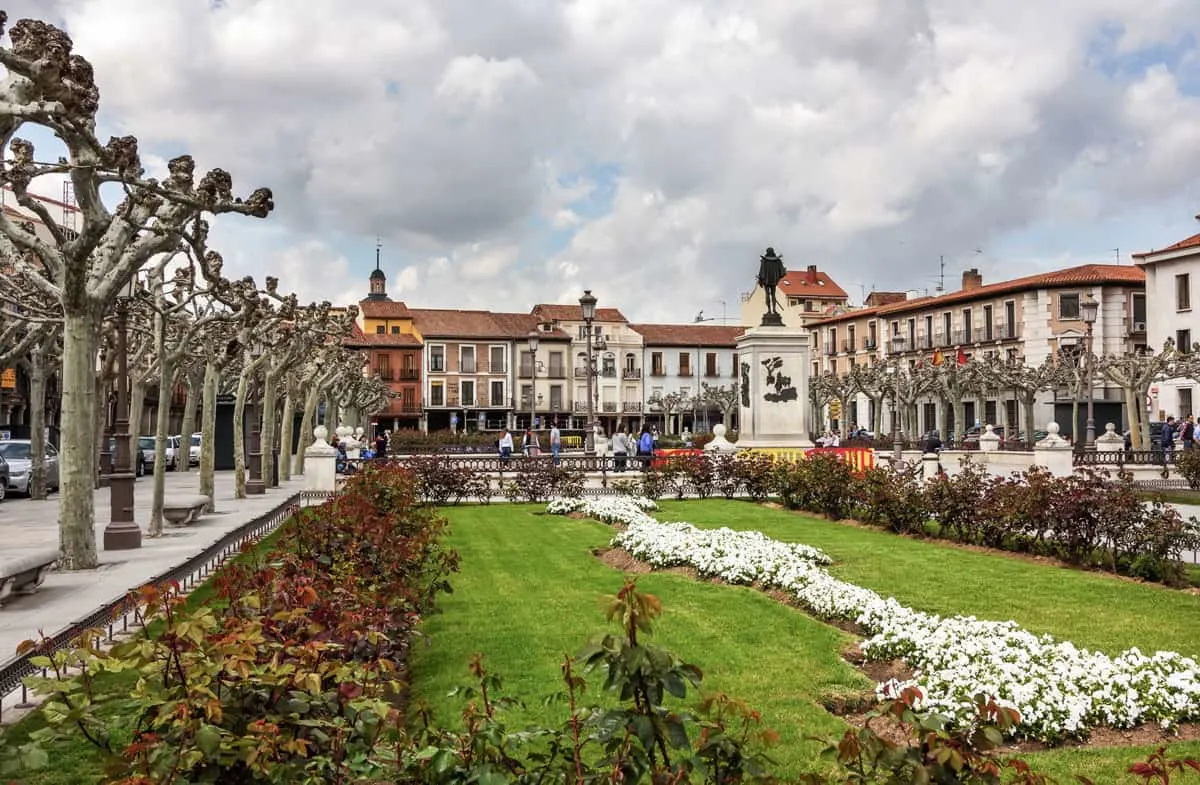
One of the easiest day trips from Madrid by train, the World Heritage-listed university town of Alcalá de Henares can be reached in under 30 minutes from Madrid.
The Cervantes Birthplace Museum is a must-visit to see where Miguel de Cervantes was born and raised. The museum transports visitors to daily life in 16th and 17th century Alcalá. It also includes a collection of furniture, ceramics and art from the period and an important library collection, including first editions.
The small UNESCO city surrounds the prestigious university campus – one of the oldest universities in the world, founded in 1486 by Cardinal Cisneros. Highlights of the University are the Mudéjar chapel and the magnificent Paraninfo auditorium, where the Spanish King and Queen award the prestigious Miguel de Cervantes Prize. The literary prize honours the lifetime achievement of an outstanding writer in the Spanish language on the anniversary of the death of Cervantes – April 23.
It is also at the University of Alcalá where Christopher Columbus first met King Ferdinand and Queen Isabel to discuss his plans for his voyage of discovery.
Worthwhile events throughout the year include the Classical Theatre Festival in summer, the Mercado Cervantino in early autumn when the streets are full of markets and activities in 17th-century style and the famous Christmas lights in December.
Don’t Miss: Alcalá is famous for its generous and delicious tapas, served in most bars when you order a drink. Try the artisanal sweets and pastries made in the city’s convents – Convento de San Diego is a favourite for candied almonds.
Tour Recommendations
- Half Day Alcalá de Henares & Cervantes Museum Day Trip from Madrid – 5 hours. Includes transport, guides and tickets.
- Private Walking Tour of the Historic Alcalá de Henares – 1.5 hrs
How to get to Alcalá de Henares from Madrid
- Bus: Approximately 45 minutes. From Avenida de América station in Madrid, the 223, 227 and 229 bus routes and the N202 (night bus) all go to Alcalá.
- Train: Approximately 25 minutes on Madrid’s Cercanias train lines.
- Car: Approx. 45 minutes from central Madrid.
Salamanca
2.20 hrs driving or 1.40 hrs by high-speed train | 214 km from Madrid | Vibrant UNESCO city | Historic University
The city of two cathedrals, Salamanca is considered one of the most beautiful world heritage cities in Spain.
While a very historic city, the university, the oldest in the Hispanic world and one of the oldest in continuous operation, continues to give Salamanca youthful energy. The city is a treasure trove of historical buildings and fascinating finds.
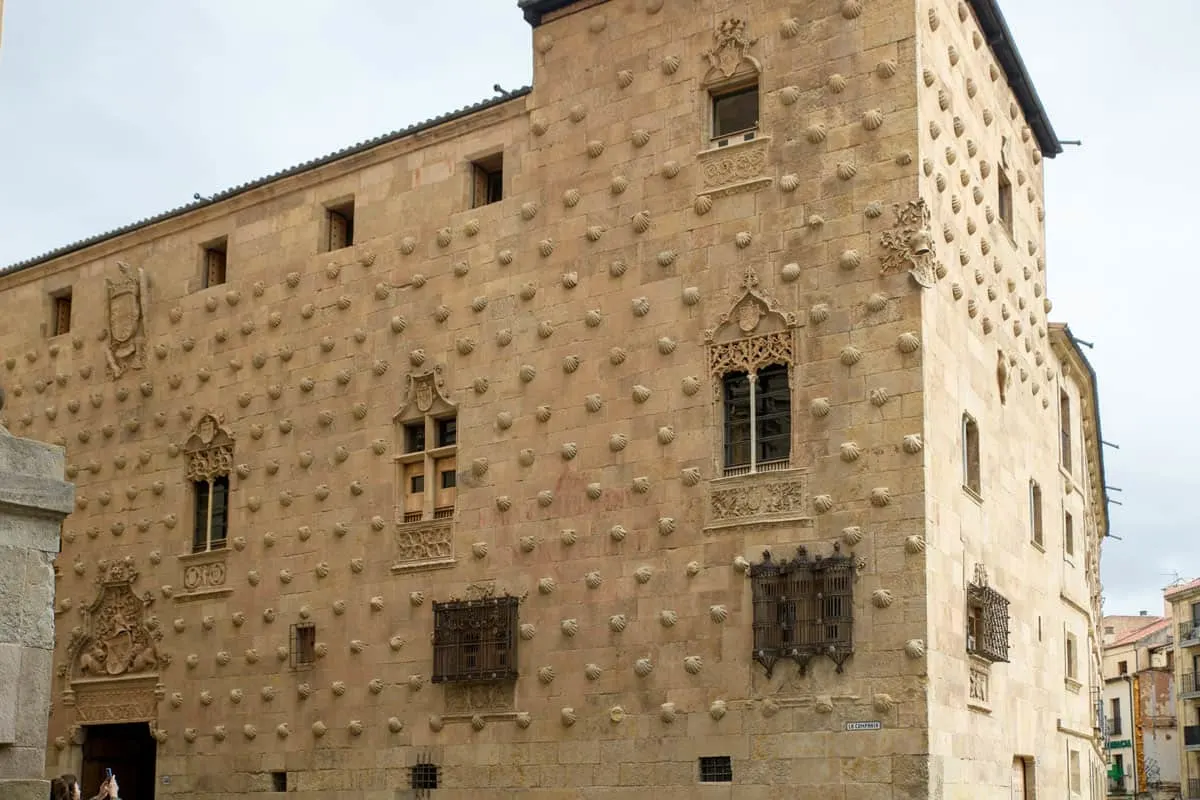
Stop for coffee or an afternoon drink at the beautiful Plaza Mayor and enjoy the endless parade of people, perhaps from the hundred-year-old Café Novelty. You may even be treated to a show in the magnificent plaza in the evening, especially in the summer.
Explore the intriguing features of the city’s most famous historical buildings, such as Casa de las Conchas (House of Shells). The building is adorned with thousands of shells placed there as a token of the marriage between two noble families. Legend says there is treasure beneath one of the shells.
At the two cathedrals of Salamanca, you will find people searching for other curious icons. In the Cathedral door, you can see carved figures of an astronaut, a monkey eating ice cream and a stork. At the university, for centuries, a secret frog carved in the gothic facade is believed to determine the success of a student’s studies based on whether you can find it.
If You Have Time: If you can manage a night in Salamanca (which we wholly recommend), it is breathtaking at night, and there is no shortage of nightlife and great places to eat.
Head to Calle Van Dyck in the north of the city for a good selection of bars and cheap and cheerful tapas places. The street will be very lively from around 9 pm.
Don’t Miss: Hornazo. A typical pie of Salamanca and Avila that is easily eaten by hand – Pastry filled with pork loin, spicy chorizo, and hard-boiled eggs.
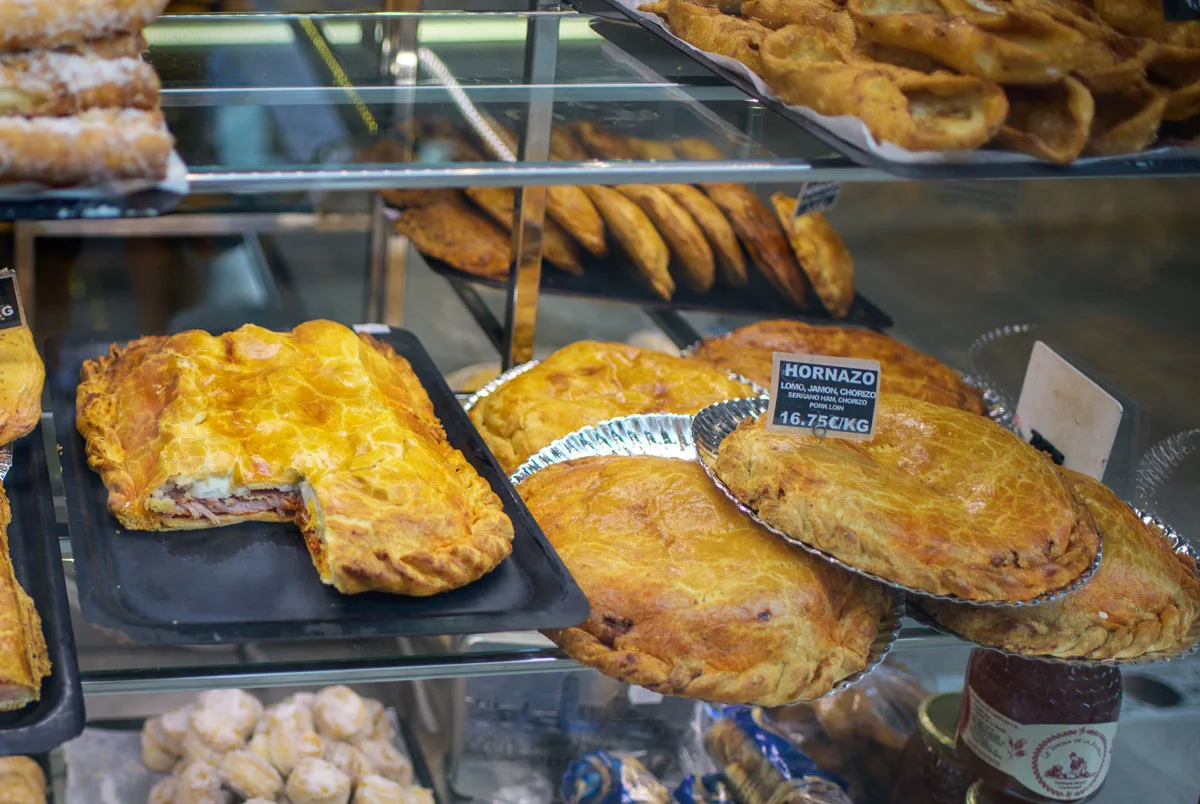
Tour Recommendations
- Tour of Avila & Salamanca from Madrid– 11 hrs. Tour both cities with transportation, guides and entry to Salamanca Cathedral.
- Monuments and Landmarks Guided Walking Tour – 2-2.5 hrs
- Salamanca Like a Local. Customized Private Tour – starting at 2 hrs
How to get to Salamanca from Madrid
- Bus: Approximately 3 hrs. Avanza and Alsa both operate bus services between Madrid and Salamanca.
- Train: Approximately 1.40 hrs. There are numerous daily services, with the fastest AVE train being 1.40 hr. Some services will be 2.20 hrs.
- Car: Approx. 2.20 hrs from central Madrid.
Cuenca
1.50 hours driving or less than an hour by fast train | 170 km | UNESCO Medieval city with fascinating houses
One of Spain’s best-kept secrets, visitors, often bypass Cuenca in favour of Toledo or Segovia. The UNESCO-listed city is worth at least a day trip from Madrid.
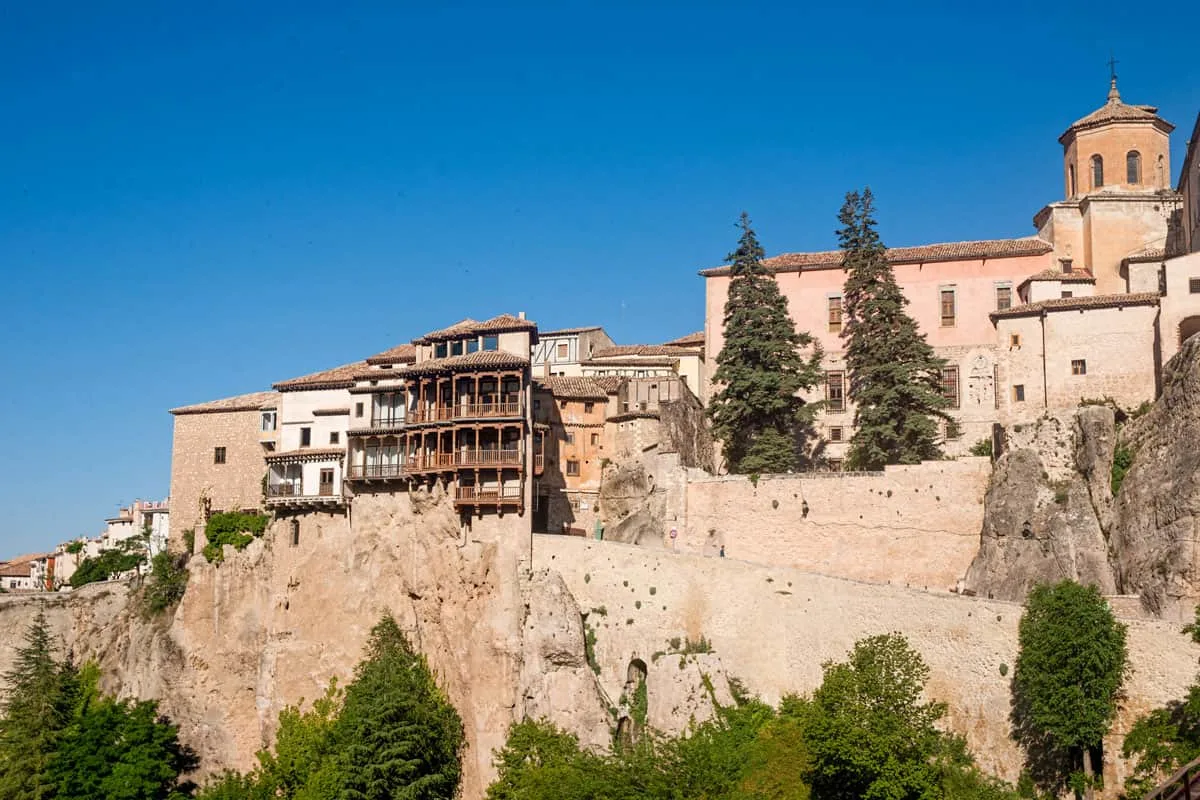
Less than two hours from Madrid, in the mountains of east-central Spain in the Castile-La Mancha region, the town’s highlight is the attention-grabbing hanging houses of Cuenca “Casas Colgadas.” Perched on a limestone spur, they cling precariously to the cliff’s edge, appearing to hover over the Huécar gorge.
Explore the steep cobbled streets of the World Heritage walled town to discover medieval castle ruins, Plaza Mayor, the Mangana Tower, the secret underground tunnels of Alfonso VIII and the Cuenca Cathedral.
There are museums to discover Cuenca’s past and culture, such as the Semana Santa Museum. But there is also a very modern side to the historic town – restaurants, hotels and landmark buildings creatively restored to reveal strikingly modern interiors, such as the Spanish Museum of Abstract Arts, housed in one of the iconic hanging houses, and the Castilla-La Mancha Science Museum.
Another important landmark and the best viewing point for the Hanging Houses is the San Paolo Bridge. The original stone bridge over the Huécar River dates back to the 16th century, connecting the town with the San Pablo convent. The original stone bridge collapsed but was rebuilt in 1902 in iron and wood. The 40-meter-high bridge may not be for those with a fear of heights, but it does offer the best photo opportunities of the unique historic town.
Must Try: Hit up the local Castilian-style restaurants to try Morteruelo, a paté style dish originating from Cuenca, Ajoarriero a cod and potato dish usually served as a starter, and the local liqueur resolí, traditionally served with alajú, a typical cake from Cuenca of spices, nuts and honey wedged between two wafers.
Tour Recommendations
- Day Trip to Cuenca and The Enchanted City from Madrid – 11 hrs Cuenca and the Enchanted City including Devil’s Window. Includes guide, transport and tickets to the Enchanted City.
- Cuenca Medieval Old Town Guided Tour – 2 Hrs
How to get to Cuenca from Madrid
- Bus: Approximately 2 hrs from Madrid Estación Sur de Autobuses. The bus station in Cuenca is close to the historic centre.
- Train: Some high-speed train services take less than an hour between Atocha Station in Madrid and Cuenca. Cuenca’s high-speed railway station is the “Fernando Zobel”, about 6 kilometres from the city centre, which is connected by bus and taxi. The Cuenca rail station, closer to town, is serviced by regional trains.
- Car: Approx. 1.50 hrs from central Madrid.
Sierra de Guadarrama Mountains
50 minutes driving or 2+hrs by train | 70 km | National Park, historic towns and Ski Resort
Less than an hour’s drive north of Madrid is the Sierra de Guadarrama mountain range in the eastern part of the Sistema Central that separates the autonomous regions of Madrid and Castilla León.
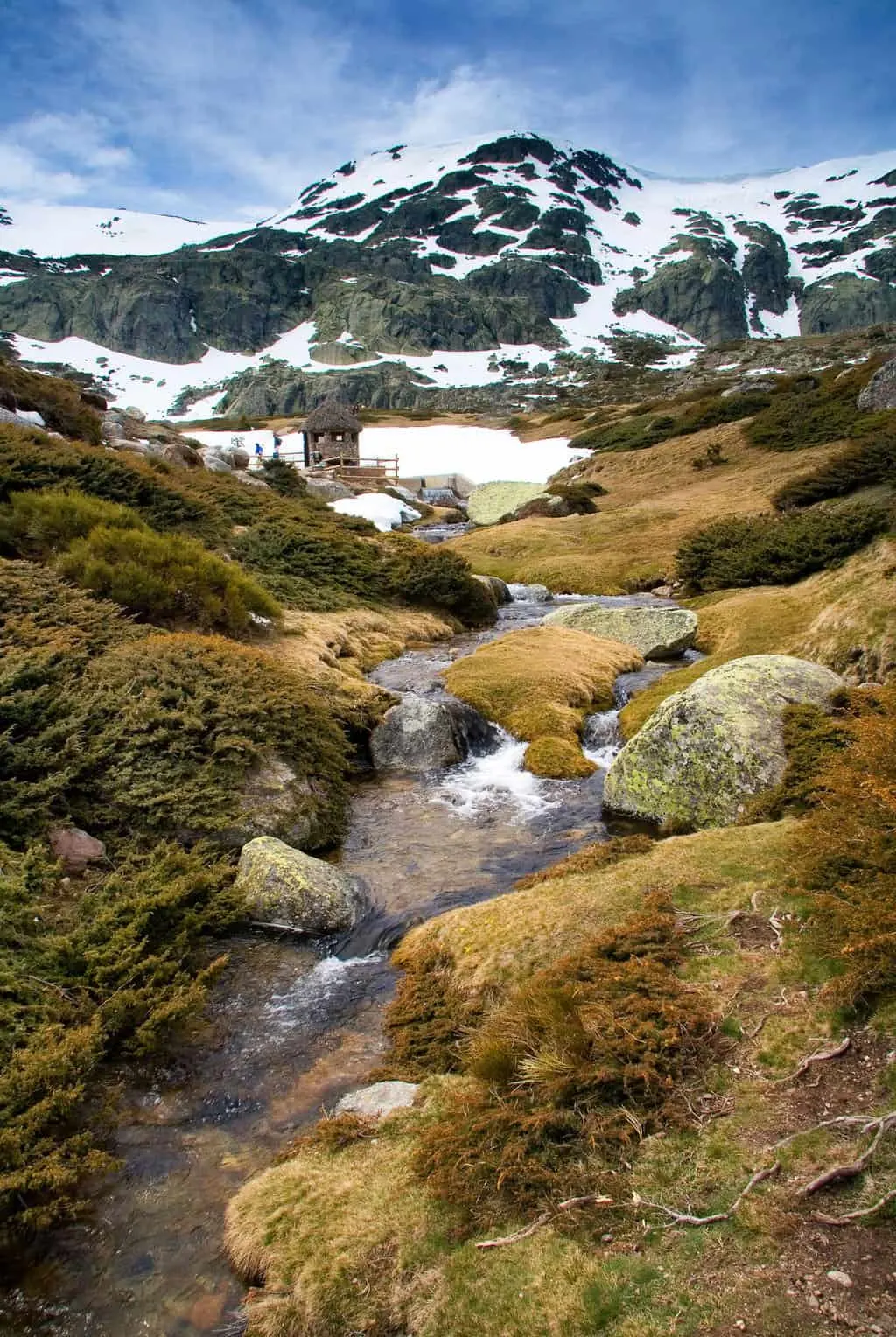
It is one of the most popular day trips from Madrid for the diversity of experiences, whether you enjoy hiking, nature, sports or exploring historic towns.
The Sierra de Guadarrama National Park covers 33,960 hectares reaching altitudes of 2,428 metres at its highest point, the Peak of Peñalara.
The national park offers visitors a magnificent diversity of terrains to explore, including vast pine forests, smaller Pyrenean oak forests, mountain grasslands, snow-covered landscapes, rocky areas, and seasonal streams, waterfalls and natural swimming areas.
Skiing in Sierra de Guadarrama
There are two ski resorts in the Sierra de Guadarrama mountain range –Valdesquí and Puerto de Nevacerrada.
Valdesquí, near the town of Rascafría, has 22 km of marked pistes, making it one of the most significant ski areas of the Sistema Central chain.
The Puerto de Navacerrada is the closest ski resort to Madrid, with 10 km of protected pistes set among picturesque pine forests. It is divided into intermediate/advanced in the upper area and intermediate/beginners’ pistes in the lower.
Tour Recommendations
- Day Trip to Guadarrama National Park from Madrid – 10 hrs. Includes transport, guide and walking tour inside Guadarrama National Park.
- Horse Riding in Sierra del Guadarrama National Park from Madrid – 2.5 hrs. Transportation, guide and all equipment.
How to get to Sierra de Guadarrama from Madrid
- Bus: Approximately 1.50 hrs from Madrid Moncloa, finishing at Ctra. M601 – Club Alpino Espanol.
- Train: Approximately 1.40 – 2 hrs. Take the train from the Atocha station in Madrid to Cercedilla on line C88. Then take another train to the Puerto de Navacerrada ski station.
- Car: Approx. 50 minutes from central Madrid.
Madrid’s Wine Country
The region of Madrid has some of the most celebrated wineries in the world. An incredible winemaking history in the Madrid wine country dates back over a century. The area is particularly famous for its Tempranillo and Garnacha grapes.
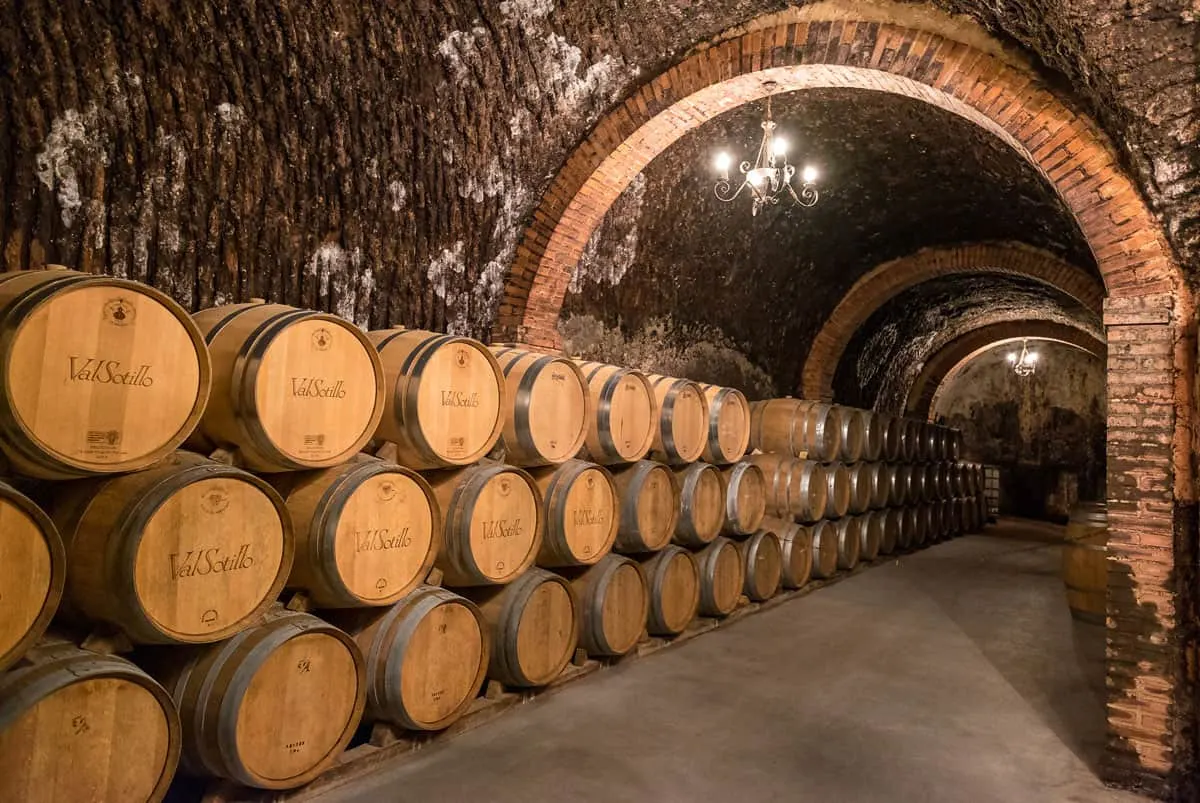
East of Madrid, you will find Arganda, the largest subregion with more than 50% of Madrid’s vineyards and 60 % of its total production. In the southwest, Navalcarnero produces 15% of its wine. In the west of Madrid, you can experience the highest-altitude vineyards of San Martin.
There are plenty of opportunities for wine-tasting tours, many incorporating visits to some of the biggest attractions close to Madrid.
Tour Recommendations
Other Day Trips from Madrid
Valencia
There is so much to do in Valencia, I believe you should spend at least a few days. However, making a day trip to Valencia from Madrid is possible. Valencia is 3 hr 50 min (359.8 km) by car. However, the high-speed train service can take as little as 1.40 hr, which makes a day trip to Valencia, the birthplace of paella, very achievable.
Tour Recommendation: 4-Day Valencia and Barcelona tour from Madrid. If you want to visit all of Spain’s big cities and see all the highlights (returning with a stop in Zaragoza), take an all-inclusive four-day tour from Madrid with accommodation, daily breakfasts, comfortable transportation, and high-speed AVE tickets between cities. See here for full tour details.
Barcelona
Again, Barcelona is a trip in its own right. However, a day trip to Barcelona is achievable on the AVE high-speed train. The fastest train service is around 2.30 hrs. Perhaps at least a night is recommended.
Córdoba
Córdoba is a city in the southern Spanish region of Andalusia, home to the largest old town in Spain and the only city in the world to have four Unesco-protected sites. The city is known for its beautiful 8th-century Mezquita (Mosque turned cathedral), the charming Alcázar, ruins of Arab baths, and a gorgeous tangle of streets in the old Judería (Jewish Quarter).
One of the most popular day trips from Seville, it is possible to make a day trip to Córdoba from Madrid on the high-speed train. Some train services are as little as 1.45hr.
Seville
Much like Barcelona, there is so much to do in Seville, a day trip would not do it justice. However, if you only had a day, the fastest high-speed train between Madrid and Seville is around 2.30 hrs making a day trip from Madrid to Seville possible.
